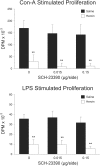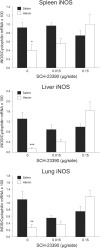Evidence for the nucleus accumbens as a neural substrate of heroin-induced immune alterations
- PMID: 19258519
- PMCID: PMC2683780
- DOI: 10.1124/jpet.108.148627
Evidence for the nucleus accumbens as a neural substrate of heroin-induced immune alterations
Abstract
Administration of opioid drugs such as heroin produces several immunosuppressive effects, including decreases in natural killer (NK) cell activity, lymphocyte proliferative responses, and nitric oxide production. Interestingly, opioids have been shown to alter many immune parameters indirectly by modulating the immunoregulatory actions of the central nervous system. Recently, it has been demonstrated that morphine inhibits NK cell activity through a neural pathway that requires the activation of dopamine D(1) receptors in the nucleus accumbens shell. The present study examined whether the nucleus accumbens also mediates the effects of heroin, a more commonly abused opioid, on several parameters of immune status in Lewis rats. The results showed that bilateral administration of the dopamine D(1) receptor antagonist R-(+)-7-chloro-8-hydroxy-3-methyl-1-phenyl-2,3,4,5-tetrahydro-1H-3-benzazepine hydrochloride (SCH-23390; 0.015 and 0.15 microg/side) into the nucleus accumbens shell blocked decreases in splenic NK activity produced by heroin (3 mg/kg s.c.) but did not attenuate the suppression of splenocyte proliferative responses to concanavalin-A or lipopolysaccharide (LPS). A subsequent experiment was performed to evaluate the effect of D(1) receptor antagonism on LPS-induced expression of inducible nitric-oxide synthase (iNOS) in vivo. These results showed that intra-accumbens SCH-23390 administration prevented heroin-induced reductions of iNOS mRNA expression in spleen, liver, and lung tissues and attenuated the suppression of nitric oxide levels in plasma. Collectively, these findings indicate that nucleus accumbens dopamine D(1) receptors are critically involved in heroin-induced immune alterations.
Figures





References
-
- Deleplanque B, Vitiello S, Le Moal M, and Neveu PJ (1994) Modulation of immune reactivity by unilateral striatal and mesolimbic dopaminergic lesions. Neurosci Lett 166 216-220. - PubMed
-
- Devoino L, Alperina E, Galkina O, and Ilyutchenok R (1997) Involvement of brain dopaminergic structures in neuroimmunomodulation. Int J Neurosci 91 213-228. - PubMed
-
- El Solh AA, Bhora M, Pineda L, and Dhillon R (2006) Nosocomial pneumonia in elderly patients following cardiac surgery. Respir Med 100 729-736. - PubMed
-
- Fecho K, Dykstra LA, and Lysle DT (1993) Evidence for β-adrenergic-receptor involvement in the immunomodulatory effects of morphine. J Pharmacol Exp Ther 265 1079-1087. - PubMed
-
- Fecho K, Maslonek KA, Dykstra LA, and Lysle DT (1996) Evidence for sympathetic and adrenal involvement in the immunomodulatory effects of acute morphine treatment in rats. J Pharmacol Exp Ther 277 633-645. - PubMed
Publication types
MeSH terms
Substances
Grants and funding
LinkOut - more resources
Full Text Sources
Medical
Miscellaneous

